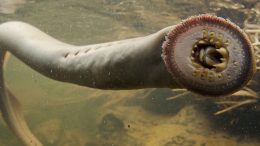Originally published by The Columbian through the Edward R. Murrow College of Communication News Fellowship. Republished under a Creative Commons license.
WOODLAND — Biologist Dave’y Lumley paced the shallow water at the mouth of the Lewis River on an overcast morning in late September. With each step, she carefully scanned the water in front of her, holding two hockey sticklike probes just under the surface.
“My mind goes blank on everything else and what I’m looking for is any slight movement,” Lumley said.
She and a colleague from the Yakama Nation’s Pacific Lamprey Project, Noah Sampson, were looking for larval lamprey — a difficult task because the fish can be less than an inch long at this stage of development.
The probes connect to a beeping, gauge-covered backpack, known as an electrofisher. Together, the rig works by gently shocking the water about three times a second to tease out young lamprey from the riverbed so they can be caught, counted and studied before being released.
This research was part of a three-day trip Lumley and Sampson, both Yakama Nation members, made to Southwest Washington to survey lamprey populations in the Wind, Washougal, Lewis and Cowlitz rivers, as well as some creeks — likely for the first time.
But it’s only one small part of the nation’s 15-year effort to restore Pacific lamprey populations to their former abundance in the Columbia River Basin after dams, habitat destruction, industrial pollution, ocean overfishing, climate change and other factors brought the important native fish species to the brink of local extinction.
What Are Lamprey?
While the Columbia River as we know it today was shaped by a series of floods about 15,000 years ago, lamprey date back much further.
At about 450 million years old, the eel-like fish evolved when Pangaea didn’t yet exist, the first trees hadn’t yet sprouted and the Pacific Northwest wouldn’t emerge from under the ocean for another couple hundred million years.
Lampreys’ life cycle starts when they hatch in gravelly streambeds and swim to slower-moving water. They then spend the next three to 10 years burrowed in the sand and silt, filter and deposit feeding.
Then, juveniles go through a metamorphosis and swim to the ocean, where they spend the next one to seven years using their hallmark “sucking disk” to attach to and feed on larger host fish. From there, they head back to rivers and streams like the ones where they were born, spending up to two years there before mating and dying.
In preparation for their Southwest Washington trip, Lumley and Sampson searched Google Earth, looking for sites along the rivers that appeared to have the sediment that creates ideal habitat for young lamprey.
Publicly accessible sites, including the ones visited that day, are ideal. But if she sees a privately owned spot she likes, Lumley has a few tricks up her sleeve.
“I don’t have a problem talking to landowners. Worst they can say is ‘No,’ ” she said. “We will go and make phone calls and send emails, go knock on the door because trespassing is not good, and we keep good relationships with people because then we can keep coming back every year.”
Lamprey Hide-and-Seek
The first step in restoring lamprey populations is finding out if any are in a river. The team does this by picking three 1-square-meter plots at a site and checking them for larval lamprey with the electrofisher. They then use those findings to establish how many are in a broader area.
Lumley was carefully pacing through the first plot of the first site to the electrofisher’s waltzlike beeps — one-two-three, one-two-three, one-two-three — when the day’s first lamprey darted from the sand.
“We got one, so they are here,” Lumley said. She smiled as she netted the small fish and deposited it in a bucket Sampson held.
Despite that promising start, it was the only lamprey the pair found at that site — or the next two. But even one fish was enough to collect important data.
Back on shore, Lumley wrangled the wriggling pinky-sized fish to measure it as Sampson collected and read off data about water and sediment depth, as well as pH.
The three-day survey trip comes after the Yakama Nation’s restoration efforts have achieved growing success in Central Washington, and especially in the Yakima River Basin.
The basin has seen higher numbers of juveniles heading to the Pacific Ocean and adults are starting to return, Ralph Lampman, leader of the Yakama Nation Pacific Lamprey Project, told The Columbian in September.
In fact, lamprey returns to the Yakima sub-basin grew fivefold from the 2000s to the 2010s, according to the Washington Department of Fish and Wildlife.
And while the data collected that day in September covered a worksheet front and back, surveys make up a small part of the broader restoration program. The Yakama Nation runs the program in partnership with other groups, including the Nez Perce Tribe, Warm Springs Tribe, Umatilla Tribe and Columbia River Inter-Tribal Fish Commission, as well as agencies including the Bonneville Power Administration and the U.S. Army Corps of Engineers.
Lumley used a tiny pair of scissors to delicately snip a fin for the Yakama Nation’s genetic monitoring program.
“I’m just going at the very back of the second dorsal and I’m just taking a little sliver,” she said.
The Yakama Nation also operates the world’s first full Pacific lamprey hatchery, Lampman said. Some of its other programs include education and outreach, training lamprey researchers from around the world and doing “translocations” — that’s when biologists truck returning fish past the dams to spawning sites throughout the Columbia Basin.
Why Save Lamprey?
This work started following the revelation that returns of the foundational Columbia River species had collapsed.
Bonneville Dam counted passing lamprey from when it opened in 1938 until 1969. In the years after the count resumed in 1999, the highest yearly returns of that period were still only roughly one-third of the highest returns of the earlier era.
And even those high returns during the mid-1900s were just a fraction of pre-dam returns, which lamprey biologists say numbered potentially in the millions.
The U.S. Army Corps of Engineers, which operates many of the dams, estimates roughly half of the lamprey that attempt to pass a dam succeed — and that’s for each dam. There are nine dams on the mainstem Columbia before fish reach the impassable Chief Joseph Dam, and hundreds more across the Snake River and other tributaries.
However, dams aren’t the only threat to lamprey. Habitat loss, ocean overfishing, climate change and other factors have hurt lamprey, too.
To Lumley, there is a brutal irony in the fact a species that survived 450 million years is now threatened within only a couple hundred years of the arrival of Euro-American settlers and industrial infrastructure —like dams.
“It’s unfortunate but it makes sense,” Lumley said. “We’re actually physically putting in an impassable barrier. But they’re still here, so hopefully they’ll outlive us.”
Cultural, Ecological Role
The pair and their gear — which Lumley says is often likened to something out of the movie “Ghostbusters” — have a way of starting conversations.
Lumley says the exchanges are a chance to conduct “impromptu educational outreach” about lamprey.
“Are they good to eat?” one angler asked.
“They’re good, yeah. They’re very high nutrition, high oils, vitamins, minerals, stuff like that,” Lumley said. “Little bit more than salmon — also they’re food for everything. Everything eats them.”
It’s those nutrients that get at the heart of the fish’s importance in the Columbia Basin — both to ecosystems and Native nations, Michael Buck said. He’s a Yakama Nation member and a researcher studying the history and intellectual traditions of Native people in the Columbia River Plateau.
While his recent research has involved interviewing dozens of Yakama elders to understand the role of lamprey in the nation’s life before settlers and dams arrived, he got his start when he was much younger.
“Our entire family from Priest Rapids Village would caravan all the way (to Willamette Falls) for a day-and-a-half of eeling,” he said, referring to lamprey with the shorthand name many Native people have long used.
From conversations with elders, Buck found the nation’s relationship to lamprey is just as deep and important as with salmon.
“The eel was important to children, to toddlers who were teething. The eel tail was used for a pacifier,” he said. “The dried eel tail, the oil was used for different medicines, like earaches and cleansing, and it was also a connection to stamina. The eel oil gave you stamina to be a strong fisherman, a strong horse rider.”
Buck, who also works as a traditional medicine practitioner at Seattle Indian Health Board, said the “quick, nutritious grab” was a part of what kept Native communities vital, and with its collapse, health problems arose.
“This stereotype came from starvation — the stereotypical alcoholic Indian with no teeth, diabetes. That’s something that the government gave to us,” he said. “The eel made us strong and fast and clean in our blood.”
(Members of the Yakama Nation have been arrested as recently as the 1980s for salmon fishing, despite that right being enshrined in treaties the U.S. made with them.)
But it hasn’t only been Native communities who have suffered without lampreys’ former abundance. Salmon and lamprey have been migrating together for as long as salmon have existed, Buck pointed out. And both the younger, more popular fish and the broader regional ecosystems need lamprey to function properly.
To Lumley, the best way to understand that is to think of the larval lamprey as doing for the river what an earthworm does for a garden.
“They churn it, they aerate it, break down organic matter and they’re good for everything,” she said. “Everything will eat them.”
It’s that importance — both cultural and ecological — that drives Lumley in her goal of restoring lamprey populations so harvests can return to what they were only a handful of generations ago.
While she didn’t taste the fish or even know much about it until she was in her early 20s, she wants other Yakama members at a young age to get to learn about lamprey and its importance — and to try it.
“When we do an educational outreach booth, we set up an aquarium with live fish so people can actually see them up close and touch them, pick them up,” she said. “It’s great being able to tie tribal youth to a traditional food source.”
Growing returns in the Yakima Basin have boosted that outreach work, and enabled them to bring back fish for members who can’t harvest them, including children and older people.
“It is very meaningful to me. I love this job,” Lumley said.
Over the past decade, she has worked her way through a college degree, and from a seasonal technician to fish biologist. She said she can’t see herself doing anything else.
It’s work that, in addition to passion and knowledge, requires and rewards a hopeful disposition: While the Lewis River only yielded one larval lamprey, Lumley and Sampson went on to find more than 60 at sites along the Cowlitz River.
“It was a really good day for lamprey,” Lumley said.
Previously in The Revelator:
Newest Flock of Wild California Condors Faces an Old Threat: Lead Poisoning




